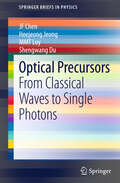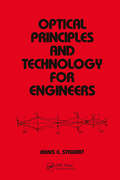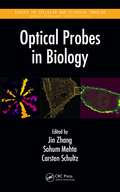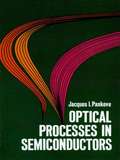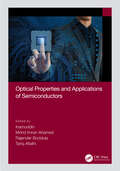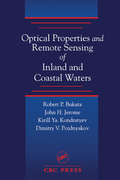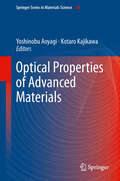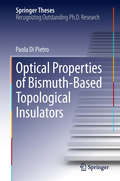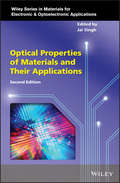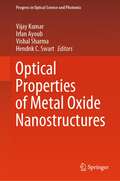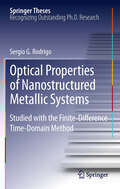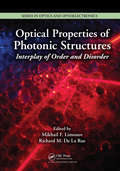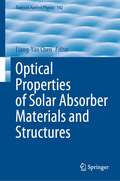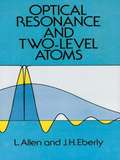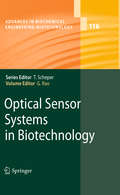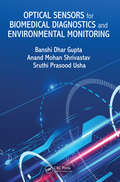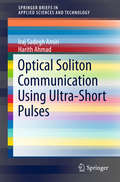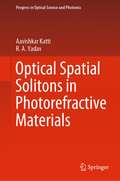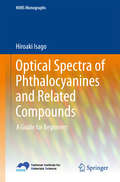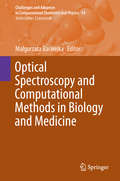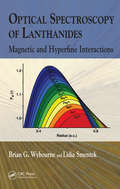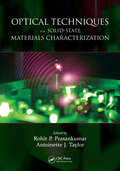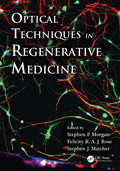- Table View
- List View
Optical Precursors: From Classical Waves to Single Photons
by Jf Chen Shengwang Du Heejeong Jeong Mmt LoyEver since Einstein's special relativity in 1905, the principle of invariant light speed in vacuum has been attracting attention from a wide range of disciplines. How to interpret the principle of light speed? Is light referred to continuous light, or light pulse with definite boundaries? Recent discovery of superluminal medium triggered vigorous discussion within the Physics community. Can communication via such "superluminal channel" break the speed limit and thus violate causality principle? Or, will a single photon, which is not governed by classical laws of Physics, tend to break the speed limit? To solve these problems, this Brief brings in Optical Precursors, the theoretical works for which started as early as 1914. This is a typical optical phenomenon combining wave propagation theory and light-wave interaction. Both theory and experimental works are covered in this Brief. The study of precursor verifies that the effective information carried by light pulses can never exceed the speed of light in vacuum- c. Further, through observation from nonclassical single photon source, the precursor rules out the probability of a single photon traveling with the speed, breaking the classical limit.
Optical Principles and Technology for Engineers (Mechanical Engineering)
by James StewartDiscussing the principles of physical and geometrical optics from an engineering point of view, this book explains current optical technology and the applications of optical methods in a wide variety of fields, from astronomy and agriculture to medicine and semiconductors. It offers guidance in the selection of optical components for the construction of bread-board models using commercially available, standard components, and provides immediately useful equations without unnecessary mathematical derivations.
Optical Probes in Biology (Series in Cellular and Clinical Imaging)
by Jin Zhang Sohum Mehta Carsten SchultzOptical probes, particularly the fluorescent varieties, enable researchers to observe cellular events in real time and with great spatial resolution. Optical Probes in Biology explores the diverse capabilities of these powerful and versatile tools and presents various approaches used to design, develop, and implement them. The book examines the use
Optical Processes in Semiconductors (Dover Books on Physics)
by Jacques I. PankoveBased on a series of lectures at Berkeley, 1968-1969, this is the first book to deal comprehensively with all of the phenomena involving light in semiconductors. The author has combined, for the graduate student and researcher, a great variety of source material, journal research, and many years of experimental research, adding new insights published for the first time in this book.Coverage includes energy states in semiconductors and their perturbation by external parameters, absorption, relationships between optical constants, spectroscopy, radiative transitions, nonradiative recombination, processes in pn junctions, semiconductor lasers, interactions involving coherent radiation, photoelectric emission, photovoltaic effects, polarization effects, photochemical effects, effect of traps on luminescence, and reflective modulation.The author has presented the subject in a manner which couples readily to physical intuition. He introduces new techniques and concepts, including nonradiative recombination, effects of doping on optical properties, Franz-Keldysh effect in absorption and emission, reflectance modulation, and many others. Dr. Pankove emphasizes the underlying principle that can be applied to the analysis and design of a wide variety of functional devices and systems. Many valuable references, illustrative problems, and tables are also provided here.
Optical Properties and Applications of Semiconductors
by InamuddinSemiconductors with optical characteristics have found widespread use in evolving semiconductor photovoltaics, where optical features are important. The industrialization of semiconductors and their allied applications have paved the way for optical measurement techniques to be used in new ways. Due to their unique properties, semiconductors are key components in the daily employed technologies in healthcare, computing, communications, green energy, and a range of other uses. This book examines the fundamental optical properties and applications of semiconductors. It summarizes the information as well as the optical characteristics and applicability of semiconductors through an in-depth review of the literature. Accomplished experts in the field share their knowledge and examine new developments. FEATURES Comprehensive coverage of all types of optical applications using semiconductors Explores relevant composite materials and devices for each application Addresses the optical properties of crystalline and amorphous semiconductors Describes new developments in the field and future potential applications Optical Properties and Applications of Semiconductors is a comprehensive reference and an invaluable resource for engineers, scientists, academics, and industry R&D teams working in applied physics.
Optical Properties and Remote Sensing of Inland and Coastal Waters
by Robert P. Bukata John H. Jerome Alexander S. Kondratyev Dimitry V. PozdnyakovOptical Properties and Remote Sensing of Inland and Coastal Waters discusses the methodology and the theoretical basis of remote sensing of water. It presents physical concepts of aquatic optics relevant to remote sensing techniques and outlines the problems of remote measurements of the concentrations of organic and inorganic matter in water. It also details the mathematical formulation of the processes governing water-radiation interactions and discusses the development of bio-optical models to incorporate optically complex bodies of water into remote sensing projects. Optical Properties and Remote Sensing of Inland and Coastal Waters derives and evaluates the interrelationships among inherent optical properties of natural water, water color, water quality, primary production, volume reflectance spectra, and remote sensing. This timely and comprehensive text/reference addresses the increasing tendency toward multinational and multidisciplinary climate studies and programs.
Optical Properties of Advanced Materials
by Shin-Ya Koshihara Yoshinobu Aoyagi Koki Takanashi Kotaro Kajikawa Katsuhiko Fujita Shin-Ichiro Inoue Yoichi TakanishiIn the last decade, optically functionalized materials have developed rapidly, from bulk matters to structured forms. Now we have a rich variety of attractive advanced materials. They are applied to optical and electrical devices that support the information communication technology in the mid 21-th century. Accordingly, it is quite important to have a broad knowledge of the optical properties of advanced materials for students, scientists and engineers working in optics and related fields. This book is designed to teach fundamental optical properties of such advanced materials effectively. These materials have their own peculiarities which are very interesting in modern optical physics and also for applications because the concepts of optical properties are quite different from those in conventional optical materials. Hence each chapter starts to review the basic concepts of the materials briefly and proceeds to the practical use. The important topics covered in this book include: quantum structures of semiconductors, spintronics, photonic crystals, surface plasmons in metallic nanostructures, photonic metamaterials, liquid crystal materials, organic LED materials and magnet-optics.
Optical Properties of Bismuth-Based Topological Insulators
by Paola PietroTopological Insulators (TIs) are insulators in the bulk, but have exotic metallic states at their surfaces. The topology, associated with the electronic wavefunctions of these systems, changes when passing from the bulk to the surface. This work studies, by means of infrared spectroscopy, the low energy optical conductivity of Bismuth based TIs in order to identify the extrinsic charge contribution of the bulk and to separate it from the intrinsic contribution of the surface state carriers. The extensive results presented in this thesis definitely shows the 2D character of the carriers in Bismuth-based topological insulators. The experimental apparatus and the FTIR technique, the theory of optical properties and Surface Plasmon Polaritons, as well as sample preparation of both crystals and thin films, and the analysis procedures are thoroughly described.
Optical Properties of Materials and Their Applications (Wiley Series in Materials for Electronic & Optoelectronic Applications)
by Peter Capper Arthur Willoughby Safa KasapProvides a semi-quantitative approach to recent developments in the study of optical properties of condensed matter systems Featuring contributions by noted experts in the field of electronic and optoelectronic materials and photonics, this book looks at the optical properties of materials as well as their physical processes and various classes. Taking a semi-quantitative approach to the subject, it presents a summary of the basic concepts, reviews recent developments in the study of optical properties of materials and offers many examples and applications. Optical Properties of Materials and Their Applications, 2nd Edition starts by identifying the processes that should be described in detail and follows with the relevant classes of materials. In addition to featuring four new chapters on optoelectronic properties of organic semiconductors, recent advances in electroluminescence, perovskites, and ellipsometry, the book covers: optical properties of disordered condensed matter and glasses; concept of excitons; photoluminescence, photoinduced changes, and electroluminescence in noncrystalline semiconductors; and photoinduced bond breaking and volume change in chalcogenide glasses. Also included are chapters on: nonlinear optical properties of photonic glasses; kinetics of the persistent photoconductivity in crystalline III-V semiconductors; and transparent white OLEDs. In addition, readers will learn about excitonic processes in quantum wells; optoelectronic properties and applications of quantum dots; and more. Covers all of the fundamentals and applications of optical properties of materials Includes theory, experimental techniques, and current and developing applications Includes four new chapters on optoelectronic properties of organic semiconductors, recent advances in electroluminescence, perovskites, and ellipsometry Appropriate for materials scientists, chemists, physicists and electrical engineers involved in development of electronic materials Written by internationally respected professionals working in physics and electrical engineering departments and government laboratories Optical Properties of Materials and Their Applications, 2nd Edition is an ideal book for senior undergraduate and postgraduate students, and teaching and research professionals in the fields of physics, chemistry, chemical engineering, materials science, and materials engineering.
Optical Properties of Metal Oxide Nanostructures (Progress in Optical Science and Photonics #26)
by Vijay Kumar Irfan Ayoub Vishal Sharma Hendrik C. SwartThis book highlights the optical properties of metal oxides at both the fundamental and applied level and their use in various applications. The book offers a basic understanding of the optical properties and related spectroscopic techniques essential for anyone interested in learning about metal oxide nanostructures. This is partly due to the fact that optical properties are closely associated with other properties and functionalities (e.g., electronic, magnetic, and thermal), which are of essential significance to many technological applications, such as optical data communications, imaging, lighting, and displays, life sciences, health care, security, and safety. The book also highlights the fundamentals and systematic developments in various optical techniques to achieve better characterization, cost-effective, user-friendly approaches, and most importantly, state-of-the-art developing methodologies for various scientific and technological applications. It provides an adequate understanding of the imposed limitations and highlights the prospects and challenges associated with optical analytical methods to achieve the desired performance in targeted applications.
Optical Properties of Nanostructured Metallic Systems
by Sergio G. RodrigoThe common belief is that light is completely reflected by metals. In reality they also exhibit an amazing property that is not so widely known: under some conditions light flows along a metallic surface as if it were glued to it. Physical phenomena related to these light waves, which are called Surface Plasmon Polaritons (SPP), have given rise to the research field of plasmonics. This thesis explores four interesting topics within plasmonics: extraordinary optical transmission, negative refractive index metamaterials, plasmonic devices for controlling SPPs, and field enhancement phenomena near metal nanoparticles.
Optical Properties of Photonic Structures: Interplay of Order and Disorder
by Mikhail F. Limonov Richard M. De La RueThe collection of articles in this book offers a penetrating shaft into the still burgeoning subject of light propagation and localization in photonic crystals and disordered media. While the subject has its origins in physics, it has broad significance and applicability in disciplines such as engineering, chemistry, mathematics, and medicine. Unli
Optical Properties of Solar Absorber Materials and Structures (Topics in Applied Physics #142)
by Liang-Yao ChenThis book presents an overview of both the theory and experimental methods required to realize high efficiency solar absorber devices. It begins with a historical description of the study of spectrally selective solar absorber materials and structures based on optical principles and methods developed over the past few decades. The optical properties of metals and dielectric materials are addressed to provide the background necessary to achieve high performance of the solar absorber devices as applied in the solar energy field. In the following sections, different types of materials and structures, together with the relevant experimental methods, are discussed for practical construction and fabrication of the solar absorber devices, aiming to maximally harvest the solar energy while at the same time effectively suppressing the heat-emission loss. The optical principles and methods used to evaluate the performance of solar absorber devices with broad applications in different physical conditions are presented. The book is suitable for graduate students in applied physics, and provides a valuable reference for researchers working actively in the field of solar energy.
Optical Resonance and Two-Level Atoms
by L. Allen J. H. Eberly"Coherent and lucid...a valuable summary of a subject to which [the authors] have made significant contributions by their own research." -- Contemporary PhysicsOffering an admirably clear account of the basic principles behind all quantum optical resonance phenomena, and hailed as a valuable contribution to the literature of nonlinear optics, this distinguished work provides graduate students and research physicists probing fields such as laser physics, quantum optics, nonlinear optics, quantum electronics, and resonance optics an ideal introduction to the study of the interaction of electromagnetic radiation with matter.The book first examines the applicability of the two-level model for atoms to real atoms, then explores semiclassical radiation theory, and derives the optical Bloch equations. It then examines Rabi inversion, optical nutation, free-induction decay, coherent optical transient effects, light amplification, superradiance, and photon echoes in solids and gases.Before the publication of this book, much of the material discussed was widely scattered in other books and research journals. This comprehensive treatment brings it together in one convenient resource. The style of writing is clear and informal and the emphasis throughout is always on the physics of the processes taking place. There are numerous helpful illustrations, excellent introductions to each chapter, and lists of references for further reading."The authors have endeavored to create a primer for the field of optical resonance...they have succeeded admirably. Their coverage of the subject is remarkably complete." -- IEEE Journal of Quantum Electronics
Optical Sensor Systems in Biotechnology
by Govind RaoOptical Sensor Systems in Biotechnology covers trends in this modern biotechnology. The book treats all aspects of this interdisciplinary technology, where knowledge, methods and expertise are required from a broad range of disciplines.
Optical Sensors and Switches
by V. Ramamurthy Kirk S. SchanzeA consideration of the development of photochemical systems with functions as optical sensors or switches, discussing materials and chemical systems, technology, and applications for target molecules and optical signal multiplexing. It contains novel applications in electrogenerated chemiluminescence and supramolecular photophysics for sensing chem
Optical Sensors for Biomedical Diagnostics and Environmental Monitoring
by Banshi Dhar Gupta Anand Mohan Shrivastav Sruthi Prasood UshaThe field of plasmonics has shown extraordinary capabilities in realizing highly sensitive and accurate sensors for environmental monitoring and measurement of biological analytes. The inherent potential of such devices has led to growing interest worldwide in commercial fiber optic chemical and biosensors. Optical Sensors for Biomedical Diagnostics and Environmental Monitoring is an essential resource for students, established researchers, and industry developers in need of a reference work on both the fundamentals and latest advances in optical fiber sensor technology in biomedical diagnostics and environmental monitoring. The book includes rigorous theory and experimental techniques of surface plasmon and lossy mode resonances, as well as real-time sensing applications of resonance techniques implemented over optical fiber substrate using bulk layer and/or nanostructures as transducer and sensing layers. In addition, discussion of various design options for real-time sensors in environmental monitoring and biomedical diagnostics make the book approachable to readers from multidisciplinary fields.
Optical Soliton Communication Using Ultra-Short Pulses
by Iraj Sadegh Amiri Harith AhmadThis brief analyzes the characteristics of a microring resonator (MRR) to perform communication using ultra-short soliton pulses. The raising of nonlinear refractive indices, coupling coefficients and radius of the single microring resonator leads to decrease in input power and round trips wherein the bifurcation occurs. As a result, bifurcation or chaos behaviors are seen at lower input power of 44 W, where the nonlinear refractive index is n2=3. 2×10−20 m2/W. Using a decimal convertor system, these ultra-short signals can be converted into quantum information. Results show that multi solitons with FWHM and FSR of 10 pm and 600 pm can be generated respectively. The multi optical soliton with FWHM and FSR of 325 pm and 880 nm can be incorporated with a time division multiple access (TDMA) system wherein the transportation of quantum information is performed.
Optical Spatial Solitons in Photorefractive Materials (Progress in Optical Science and Photonics #14)
by Aavishkar Katti R.A. YadavThis book highlights recent advances of optical spatial solitons in photorefractive materials ranging broadly from the coupling, modulation instability, effect of pyroelectricity, and the stability of photorefractive solitons, among other topics. Photorefractive solitons have been at the forefront of research because of their formation at low laser powers and unique saturable nonlinearity present in photorefractive materials which supports solitons in (2+1) D. There has been a spurt in research on photorefractive solitons recently, which has contributed to a greater understanding of the theoretical foundation of photorefractive solitons as also of their various interesting and practical applications. The book elucidates the diversity of photorefractive solitons and provides a good resource for students, researchers, and professionals in the area of nonlinear optics.
Optical Spectra of Phthalocyanines and Related Compounds
by Hiroaki IsagoThis book displays how optical (absorption, emission, and magnetic circular dichroism) spectra of phthalocyanines and related macrocyclic dyes can be varied from their prototypical ones depending on conditions. As these compounds can be involved in colorful chemistry (which might be driven by impurities in solvents), their spectra behave like the sea-god Proteus in their mutability. Therefore, those who have been engaged with phthalocyanines for the first time, including even educated professional researchers and engineers, may have been embarrassed by the deceptive behavior of their compounds and could have, in the worst cases, given up their projects. This book is aimed not merely at reviewing the optical spectra, but also at helping such people, particularly beginners, to figure them out by showing some examples of their prototypical spectra and their variations in several situations. For the purpose of better understanding, the book also provides an introduction to their theoretical backgrounds as graphically as possible and without mathematicization for readers who are weak in mathematics.
Optical Spectroscopic and Microscopic Techniques: Analysis of Biological Molecules
by Harekrushna SahooThis book illustrates the significance of various optical spectroscopy and microscopy techniques, including absorption spectroscopy, fluorescence spectroscopy, infrared spectroscopy, and Raman spectroscopy for deciphering the nature of biological molecules. The content of this book chiefly focuses on (1) the principle, theory, and instrumentation used in different optical spectroscopy techniques, and (2) the application of these techniques in exploring the nature of different biomolecules (e.g., proteins, nucleic acids, enzymes, and carbohydrates). It emphasizes the structural, conformational and dynamic, and kinetic including the changes in biomolecules under a range of conditions. In closing, the book summarizes recent advances in the field of optical spectroscopic and microscopic techniques.
Optical Spectroscopy and Computational Methods in Biology and Medicine
by Malgorzata BaranskaThis multi-author contributed volume gives a comprehensive overview of recent progress in various vibrational spectroscopic techniques and chemometric methods and their applications in chemistry, biology and medicine. In order to meet the needs of readers, the book focuses on recent advances in technical development and potential exploitations of the theory, as well as the new applications of vibrational methods to problems of recent general interest that were difficult or even impossible to achieve in the not so distant past. Integrating vibrational spectroscopy and computational approaches serves as a handbook for people performing vibrational spectroscopy followed by chemometric analysis hence both experimental methods as well as procedures of recommended analysis are described. This volume is written for individuals who develop new methodologies and extend these applications to new realms of chemical and medicinal interest.
Optical Spectroscopy of Lanthanides: Magnetic and Hyperfine Interactions
by Brian G. Wybourne Lidia SmentekOptical Spectroscopy of Lanthanides: Magnetic and Hyperfine Interactions represents the sixth and final book by the late Brian Wybourne, an accomplished pioneer in the spectroscopy of rare earth ions, and Lidia Smentek, a leading theoretical physicist in the field. The book provides a definitive and up-to-date theoretical description of spec
Optical Techniques for Solid-State Materials Characterization
by Rohit P. Prasankumar Antoinett E J. TaylorOver the last century, numerous optical techniques have been developed to characterize materials, giving insight into their optical, electronic, magnetic, and structural properties and elucidating such diverse phenomena as high-temperature superconductivity and protein folding. Optical Techniques for Solid-State Materials Characterization provides
Optical Techniques in Regenerative Medicine
by Stephen P. Morgan Felicity R. A. J. Rose Stephen J. MatcherIn regenerative medicine, tissue engineers largely rely on destructive and time-consuming techniques that do not allow in situ and spatial monitoring of tissue growth. Furthermore, once the therapy is implanted in the patient, clinicians are often unable to monitor what is happening in the body. To tackle these barriers, optical techniques have bee
